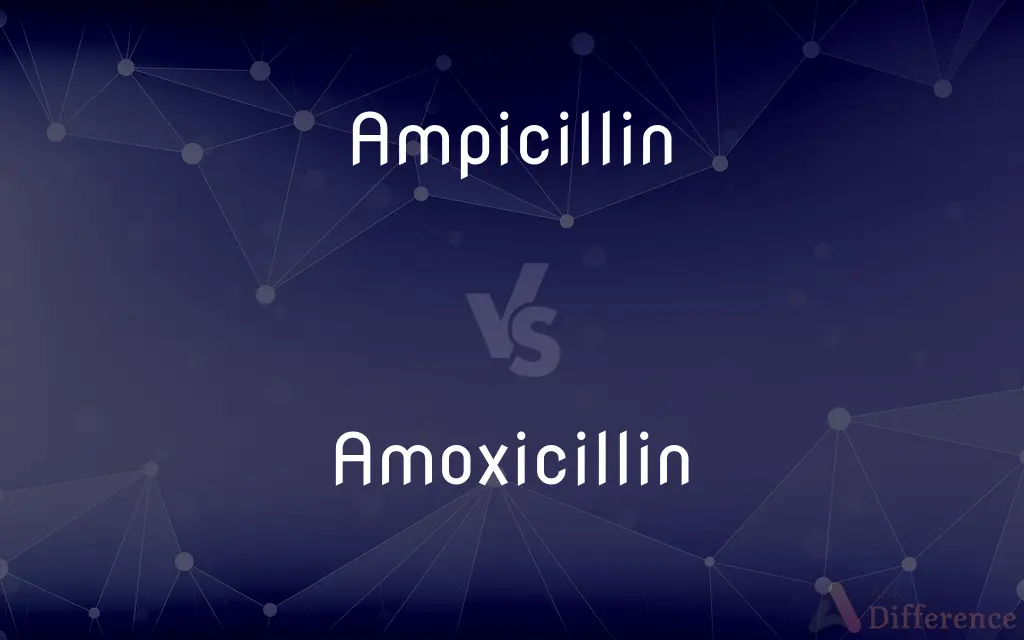Ampicillin vs. Amoxicillin — What's the Difference?
By Tayyaba Rehman — Updated on October 27, 2023
Both Ampicillin and Amoxicillin are antibiotics used to treat bacterial infections, but they differ in their molecular structures and spectrum of activity. Amoxicillin is often better absorbed when taken orally.

Difference Between Ampicillin and Amoxicillin
Table of Contents
ADVERTISEMENT
Key Differences
Ampicillin and Amoxicillin are both antibiotics that belong to the penicillin class, designed to combat bacterial infections. They function by inhibiting the synthesis of bacterial cell walls, thereby preventing bacteria from growing and multiplying. However, they are not identical and have distinct properties and uses.
Ampicillin, introduced in the 1960s, has a broader spectrum of activity compared to the original penicillin. It's effective against both Gram-positive and some Gram-negative bacteria. Amoxicillin, on the other hand, is a semi-synthetic derivative of penicillin, which has a similar but slightly different spectrum of bacterial coverage.
One notable distinction between Ampicillin and Amoxicillin is how they are administered. While both can be given orally, Ampicillin is often given intravenously in hospital settings. Conversely, Amoxicillin is more commonly prescribed for oral administration because of its superior absorption in the digestive tract.
Another difference is their side-effect profiles. Like all medications, both Ampicillin and Amoxicillin can cause side effects, but they may differ slightly between the two. For instance, Amoxicillin might be less likely to cause certain gastrointestinal side effects compared to Ampicillin.
Lastly, while both are used to treat various infections, the specifics of when one is preferred over the other can vary based on the bacteria causing the infection and the patient's overall health and history.
ADVERTISEMENT
Comparison Chart
Class
Penicillin antibiotic
Penicillin antibiotic
Spectrum
Broad, against Gram-positive and some Gram-negative
Slightly different broad spectrum
Administration
Often intravenous, also oral
Primarily oral due to better absorption
Introduction
1960s
Semi-synthetic derivative
Side-effect profile
Can cause gastrointestinal effects among others
Often fewer gastrointestinal side effects
Compare with Definitions
Ampicillin
An antibiotic often administered intravenously in hospitals.
After the surgery, the patient was given Ampicillin via an IV drip.
Amoxicillin
A widely-used, orally-administered antibiotic.
Amoxicillin is often prescribed for children with ear infections.
Ampicillin
A broad-spectrum antibiotic of the penicillin class.
The doctor prescribed Ampicillin to combat the patient's bacterial infection.
Amoxicillin
Known for its enhanced absorption in the digestive system.
She was given Amoxicillin tablets to take at home, ensuring effective treatment.
Ampicillin
A drug used against several bacterial infections.
Ampicillin proved effective against the patient's throat infection.
Amoxicillin
Effective against a variety of Gram-positive and Gram-negative bacteria.
Her urinary tract infection was quickly addressed with Amoxicillin.
Ampicillin
A bactericidal agent that inhibits bacterial cell wall synthesis.
The bacterial growth was halted by the action of Ampicillin.
Amoxicillin
A commonly prescribed antibiotic for various bacterial infections.
To treat the strep throat, Amoxicillin was the doctor's first choice.
Ampicillin
Ampicillin is an antibiotic used to prevent and treat a number of bacterial infections, such as respiratory tract infections, urinary tract infections, meningitis, salmonellosis, and endocarditis. It may also be used to prevent group B streptococcal infection in newborns.
Amoxicillin
A semi-synthetic penicillin antibiotic with broad-spectrum activity.
The dentist prescribed Amoxicillin to prevent potential infections after the extraction.
Ampicillin
A broad-spectrum semisynthetic penicillin, C16H19N3O4S, that is used, often in the form of its sodium salt, to treat infections of the intestinal, urinary, and respiratory tracts.
Amoxicillin
Amoxicillin is an antibiotic used to treat a number of bacterial infections. These include middle ear infection, strep throat, pneumonia, skin infections, and urinary tract infections among others.
Ampicillin
(pharmaceutical drug) A semisynthetic form of penicillin C16H19N3O4S that is effective against gram-negative and gram-positive bacteria and is used to treat infections of the urinary, respiratory, and intestinal tracts.
Amoxicillin
A semisynthetic penicillin, C16H19N3O5S, having an antibacterial spectrum of action similar to that of ampicillin.
Ampicillin
A semisynthetic penicillin which can be considered as the common benzylpenicillin containing an amino group at the alpha benzyl position.
Amoxicillin
(pharmaceutical drug) A moderate-spectrum, bacteriolytic beta-lactam antibiotic C16H19N3O5S closely related to ampicillin and with similar properties, but more readily absorbed when taken orally. It is used to treat bacterial infections caused by susceptible microorganisms.
Ampicillin
Semisynthetic penicillin (trade names Principen and Polycillin and SK-Ampicillin)
Amoxicillin
An antibiotic; a semisynthetic oral penicillin (trade names Amoxil and Larotid and Polymox and Trimox and Augmentin) used to treat bacterial infections
Ampicillin
A derivative of penicillin effective against a wide range of bacteria.
For his ear infection, Joe was treated with Ampicillin.
Common Curiosities
Are Ampicillin and Amoxicillin the same?
No, while both are penicillin antibiotics, they have different properties and uses.
Can both be used for throat infections?
Yes, both can be prescribed for bacterial throat infections.
Which one is better absorbed orally?
Amoxicillin is better absorbed when taken orally compared to Ampicillin.
Can they treat viral infections?
No, they are antibiotics meant for bacterial infections.
Are there any allergic reactions associated with them?
Yes, individuals allergic to penicillin may react to both.
Are they safe for pregnant women?
Both are generally considered safe during pregnancy, but a doctor should always be consulted.
Which is more likely to cause stomach upset?
Ampicillin might have a higher likelihood, but it varies between individuals.
How long do you typically take them?
Duration varies based on the infection but often ranges from 7-14 days.
Do they interact with alcohol?
While not directly, it's best to avoid alcohol as it can enhance side effects.
Which one is older in terms of introduction?
Ampicillin was introduced before Amoxicillin.
Are there resistant bacteria to these antibiotics?
Yes, antibiotic resistance is a concern, and some bacteria are resistant.
Can they be taken with other medications?
It depends on the medication. Always consult with a doctor or pharmacist.
Can they be used for dental infections?
Yes, they can be prescribed for bacterial dental infections.
Are they available over the counter?
No, they are prescription antibiotics.
How should they be stored?
They should be stored in a cool, dry place, away from direct sunlight.
Share Your Discovery

Previous Comparison
Amphibolite vs. Amphibole
Next Comparison
Lycopodium vs. SelaginellaAuthor Spotlight
Written by
Tayyaba RehmanTayyaba Rehman is a distinguished writer, currently serving as a primary contributor to askdifference.com. As a researcher in semantics and etymology, Tayyaba's passion for the complexity of languages and their distinctions has found a perfect home on the platform. Tayyaba delves into the intricacies of language, distinguishing between commonly confused words and phrases, thereby providing clarity for readers worldwide.















































